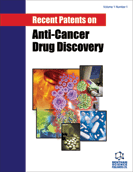
Abstract
E1A is a multifunctional adenoviral protein expressed early after infection that interferes with numerous important regulatory processes by interaction with host cell proteins or direct transcriptional activation of target genes. Although, initially identified as the adenoviral component that can cause malignant conversion of rodent cells, remarkable tumorsuppressive effects of E1A on various types of human cancer cells were observed. Gene therapeutic approaches with E1A are currently evaluated in animal models and early clinical studies. Therapeutic applications of E1A are covered by a series of patents which include the description of small variants (mini-E1A) that can be used for tumor suppression and E1A gene transfer in combination with conventional chemotherapy. In this mini review, we provide an introduction to E1A functions, summarize relevant patents, and discuss potential clinical applications of E1A gene transfer on basis of recent results of clinical and preclinical investigations.
Keywords: Gene therapy, adenovirus, E1A, breast cancer, ovarian cancer, head and neck cancer, apoptosis, HER-2/neu
Recent Patents on Anti-Cancer Drug Discovery
Title: Therapeutic Transfer of DNA Encoding Adenoviral E1A
Volume: 2 Issue: 1
Author(s): Helmut Deissler and Bertram Opalka
Affiliation:
Keywords: Gene therapy, adenovirus, E1A, breast cancer, ovarian cancer, head and neck cancer, apoptosis, HER-2/neu
Abstract: E1A is a multifunctional adenoviral protein expressed early after infection that interferes with numerous important regulatory processes by interaction with host cell proteins or direct transcriptional activation of target genes. Although, initially identified as the adenoviral component that can cause malignant conversion of rodent cells, remarkable tumorsuppressive effects of E1A on various types of human cancer cells were observed. Gene therapeutic approaches with E1A are currently evaluated in animal models and early clinical studies. Therapeutic applications of E1A are covered by a series of patents which include the description of small variants (mini-E1A) that can be used for tumor suppression and E1A gene transfer in combination with conventional chemotherapy. In this mini review, we provide an introduction to E1A functions, summarize relevant patents, and discuss potential clinical applications of E1A gene transfer on basis of recent results of clinical and preclinical investigations.
Export Options
About this article
Cite this article as:
Deissler Helmut and Opalka Bertram, Therapeutic Transfer of DNA Encoding Adenoviral E1A, Recent Patents on Anti-Cancer Drug Discovery 2007; 2 (1) . https://dx.doi.org/10.2174/157489207779561471
| DOI https://dx.doi.org/10.2174/157489207779561471 |
Print ISSN 1574-8928 |
| Publisher Name Bentham Science Publisher |
Online ISSN 2212-3970 |
 15
15
- Author Guidelines
- Graphical Abstracts
- Fabricating and Stating False Information
- Research Misconduct
- Post Publication Discussions and Corrections
- Publishing Ethics and Rectitude
- Increase Visibility of Your Article
- Archiving Policies
- Peer Review Workflow
- Order Your Article Before Print
- Promote Your Article
- Manuscript Transfer Facility
- Editorial Policies
- Allegations from Whistleblowers
Related Articles
-
Suppression of NF-κB Signaling and P-glycoprotein Function by Gambogic Acid Synergistically Potentiates Adriamycin -induced Apoptosis in Lung Cancer
Current Cancer Drug Targets Histone Lysine-Specific Methyltransferases and Demethylases in Carcinogenesis: New Targets for Cancer Therapy and Prevention
Current Cancer Drug Targets Cytochrome P450-Activated Prodrugs: Targeted Drug Delivery
Current Medicinal Chemistry Differentiation-Inducing Therapy for Solid Tumors
Current Pharmaceutical Design Hypoxia in Du-145 Prostate Cancer Xenografts After Estramustine Phosphate and Radiotherapy
Current Radiopharmaceuticals The Epidemiological, Mechanistic and Potential Clinical Role of Androgen Receptor (AR) in Urothelial Carcinoma
Current Drug Targets Antiviral Medication in Sexually Transmitted Diseases. Part I: HSV, HPV
Mini-Reviews in Medicinal Chemistry Sinonasal Carcinoma: Updated Phenotypic and Molecular Characterization
Current Cancer Therapy Reviews Direct Targeting of the Ras GTPase Superfamily Through Structure- Based Design
Current Topics in Medicinal Chemistry A New Antitumor Agent, (3-chloro-7-methoxyfuro[2,3-b]-quinolin-4-yl)-(4-methoxyphenyl) amine, Loaded in Solid Lipid Nanoparticles: Characterization and Pharmacokinetics
Current Nanoscience Statins and Type 2 Diabetes Mellitus: An Update After 1 Year
Current Pharmaceutical Design Vasopressin in Health and Disease with a Focus on Affective Disorders
Central Nervous System Agents in Medicinal Chemistry Connection between JAK/STAT and PPARγ Signaling During the Progression of Multiple Sclerosis: Insights into the Modulation of T-Cells and Immune Responses in the Brain
Current Molecular Pharmacology Small Molecule Aurora Kinases Inhibitors
Current Medicinal Chemistry Recent Progress in the Development of Anticancer Agents
Current Medicinal Chemistry - Anti-Cancer Agents The Role of COX-2 in Oral Cancer Development, and Chemoprevention/ Treatment of Oral Cancer by Selective COX-2 Inhibitors
Current Pharmaceutical Design Pharmacophore Modeling and 3D QSAR Studies of Novel Human Carbonic Anhydrase IX Inhibitors
Letters in Drug Design & Discovery Recent Progress in Phosphoinositide 3-Kinases: Oncogenic Properties and Prognostic and Therapeutic Implications
Current Protein & Peptide Science The Roles of Chromatin Remodeling Proteins in Cancer
Current Protein & Peptide Science Multimodality Imaging of CXCR4 in Cancer: Current Status towards Clinical Translation
Current Molecular Medicine


























